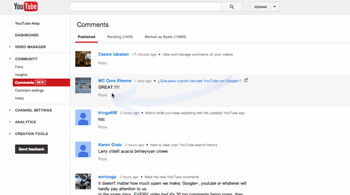One thing that every brand knows is how important video is. One thing that might shock you though is when it comes to a marketing strategy for the videos they make, even though they may be regularly producing and posting videos on their online properties, they have little or no plans or objectives when it comes to a comprehensive marketing strategy for their video content.
This is something to take note of. Video is important. In fact, people that go online today spend over a third of their online time watching video content. So how you launch your video marketing strategy matters.
After all, you want to get more engagement and conversion, right?
With this in mind, today we want to share the right methods to follow for a comprehensive video promotion strategy.
Understand your Audience and Set Campaign Goals
Just like any other digital marketing campaign you would kick off for your brand, it all starts with research. You need to have solid target personas fully developed.
Target personas are a semi-fictional accounting of your ideal clients. You can use this persona work up to decide what type of content would be seen as the most pertinent and value-added for your ideal customers.
Not only that, you can predict what channels (e.g. Facebook, LinkedIn, Youtube, etc.) that they are most likely to be on and likely to find your content on.
This is a critical step. After all, what is the point of developing great content that people don’t think is relevant, or that people never see in the first place?
Next, you need to decide what the goals of your video marketing campaign are. You have to have a goal. Goals will help you measure the overall effectiveness of your campaign.
Ways to Measure Your Video Campaign’s Success
So what kinds of goals can you use to measure whether the campaign was a success or failure? Let’s look at some key goals you can use to track and measure the success of your campaigns:
Engagement rate
Engagement rate measures any interaction someone has with your video. How much time did someone spend on the video? Did they watch the whole thing or leaving early, or merely skipping over the entire thing?

This number should give you an indication of the quality of your message, creative, and whether your video is too long or the right length.
View Count
View count is how many times a video has been watched, but this is measured differently across different channels.

On YouTube a view is considered 30 seconds, while on Facebook it’s only 3 seconds. So understanding how viewers are interacting with your videos across different channels gives you a true understanding of how people are absorbing your content and allows you to plan future campaigns and content.
Social Sharing
Social sharing is the measurement of how many times your video has been shared by people on social media channels.
If people aren’t sharing your content, they aren’t interested in it. So you want to make sure your videos are getting lots of shares, to confirm that your content is resonating.
Comments
Reading through comments and taking inventory of whether the comments are generally positive or negative in nature is an important consideration.
After all, if people are taking the time to not only watch your video but also take the time to leave a comment, they are engaging.

This is great. The trick here is you want to make sure your content and your messaging is leaving a generally positive impression with users to ensure you are helping build your brand and not break it down.
Stay on Brand, and Nail Down Your Message Across Videos
Video may seem vastly different than your other marketing efforts, say such as blogging.
It is important though that you remember that it’s not. It has to fit in logically and be on brand and on message.
Viewers watching your videos need to know that your video is coming from the exact same brand that they are familiar with engaging with online via blogs, infographics, white papers and other media. You don’t want to catch them off guard or confuse them.
Forbes magazine reported a study that was performed and it was found that companies with consistent branding are more than 20% more effective in their campaigns than those that roll out campaigns that exhibit a lack of consistency of tone and message.
It’s also important to remember that consistent branding doesn’t stop at simply keeping consistent tone and message.
For instance, if your video is being hosted on a third-party platform, say such as Youtube, you need to be sure to have a clear, detailed description in the video notes that links to your website, gives your clear value proposition and has a compelling call to action.
You want to follow this process and also make it consistent across every media channel you are using.
Be Mindful of How Much You Spend on Videos and Campaigns
While the saying, “you get what you pay for” applies to many things, interestingly enough, this doesn’t always translate to video marketing.
While of course you want the content to be compelling and drive people to want to watch it, it’s not always the brand that spends the most money that is going to be the most successful.
A popular trend in video today is creating compelling videos that aren’t super produced and polished. This is especially popular right now with millennials. Videos that aren’t as polished are seen as more authentic and allow a brand to make better connections with their customers and potential customers.
So when planning the budget for your video and campaign, definitely keep this in mind.
If you have limited funds available, depending upon your brand and your target audience, it may make sense to spend a little less on the actual production of your video content so you can then devote more money to the ad spend on the marketing campaign to get more people engaging with your content.
Remember: Each Channel is Contextual
One of the biggest traps brands fall into, especially when it comes to video is assuming that a single video will work no matter what channel they choose to run their campaign on.
This is not the case. Every different channel you are considering using for your video campaign was built with a different contextual framework.
Depending on which channels you choose to launch your video campaign, you’ll need to make sure you have different versions of your video that are best optimized for the particular channel it is going to go on.
For instance, Instagram has a minimum of 3 seconds and a maximum of 60 seconds for a video ad on their platform.
So you’ll need to make an excerpt of your main video that has a super compelling clip that will get the user to click through to watch your main video.
Facebook videos on the other hand that contain captions tend to do much better than those without, so you’ll want add captions to the video you are using to drive people to your main piece of video content.
Facebook also doesn’t have a limit of 60 seconds for a video clip in an ad, so you’ll want to test and review metrics, determining the optimal video length to get users to click through to your main video content.
Test, Test, and When You Think You Are Done Testing, Test Again
Much like display ads, you have to A/B test your video campaigns as well to find out what is working, what isn’t and to optimize them as much as possible.
Start with A/B testing the messaging, then perhaps test your targeting. You could even test for channels, killing the campaigns on channels that are not performing and scaling the ad spend on campaigns that are performing exceptionally well.
You may even consider that the creative needs A/B tested. For instance, if you are running video ads to drive people to your main content, the length of that ad “teaser” video may impact your click through rate.
The take-home point here is you need to always be testing. Those that test and refine and repeat are going to see the highest engagement and results on their campaigns.
How Do You Currently Measure The Success of Your Video Marketing Efforts?
With the growth of video marketing, it’s important to properly measure video efforts.
Are you starting to use video at all? If not, now’s the best time to start. Whether you’re a business to consumer or business to business we can get you started with a solution. Let us know if you need help, or have more tips in the comments below.


